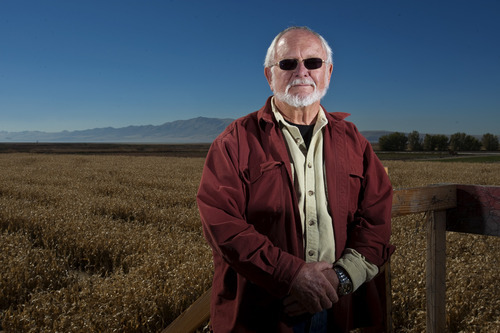This is an archived article that was published on sltrib.com in 2012, and information in the article may be outdated. It is provided only for personal research purposes and may not be reprinted.
The governor and lawmakers have declined to fund a program aimed at preserving Utah's working farms, a decision that prevents the state from qualifying for federal conservation money.
The LeRay McAlister Fund over the past 10 years has helped preserve from development 84,000 acres of land, most of it agricultural, recreational or archaeological sites. During that time, the state pitched in $21 million that was matched by $174 million from the federal government and other sources, a 9-to-1 ratio, according to the Utah Nature Conservancy group.
The program, however, has not been funded for the past two years, depleting resources for any new projects.
"We had no champions," Utah Agriculture Commissioner Leonard Blackham said of the program. "It's unfortunate."
The fund paid property owners for development rights, putting conservation easements on their lands. With the easements, farmers and ranchers were able to keep their properties in production, but when they sold them, whoever bought the property could not develop it for other uses.
Blackham told lawmakers population growth along the Wasatch Front has come at the expense of some of the state's most important — and irreplaceable — farmlands.
Starting in the 1980s, the loss to housing tracts, strip malls and developments became a worry, only to escalate in the years since, impacting the state's ability to grow foods and threatening food security, he said.
A spokeswoman for Gov. Gary Herbert has said that as the economy improves, the governor hopes to add funding for the LeRay McAlister conservation program in future budgets.
But Charles Black, owner of Black Island Farms, said the lack of immediate funding is a loss to the state.
In 2000, Black Island Farms was the first project financed by the fund, which paid for development rights on the Syracuse property. Each year the farm — which is surrounded by subdivisions — opens its fields for harvest festivals and student field trips.
"I understand that not everything can be funded in tight economic times, but it's shortsighted in the long term when you can't save farmlands," said Black. "With agriculture, you've one chance to save the land, because when it's gone, it's lost forever."
Dave Livermore, director of the Nature Conservancy Utah Field Office, said in a statement to lawmakers that cuts to the McAllister fund have been disproportionate to other natural-resource programs.
"Not only was this a missed opportunity for Utah," he said, "it also compared unfavorably with neighboring western states, which continue to invest much more in similar programs despite the current economic climate."
Twitter@DawnHouseTrib —
LeRay McAlister Fund
The governor and lawmakers said no to funding this year. The program has funded:
92 projects • Completed conserving or restoring more than 84,000 acres
Benefits • All projects endorsed by local governments; protected lands remaining on the tax rolls
Matching monies • $21 million attracted $174 million from state, local, federal and private sources, nearly a 9-to-1 ratio
Transactions • Honored private property rights; all had willing buyers and willing sellers
Endorsements • From a coalition of farmers, conservationists, planners, local civic leaders and land management agencies
Source: Utah Nature Conservancy



